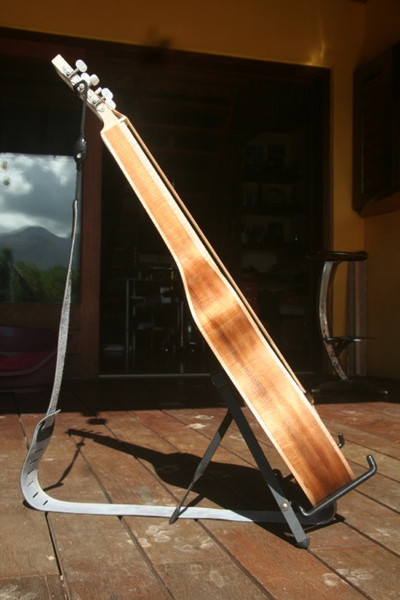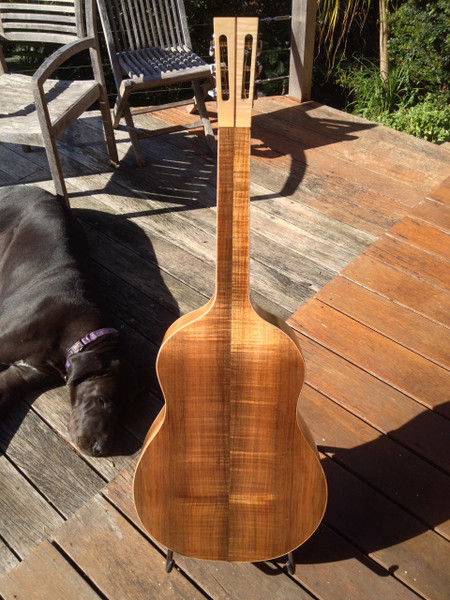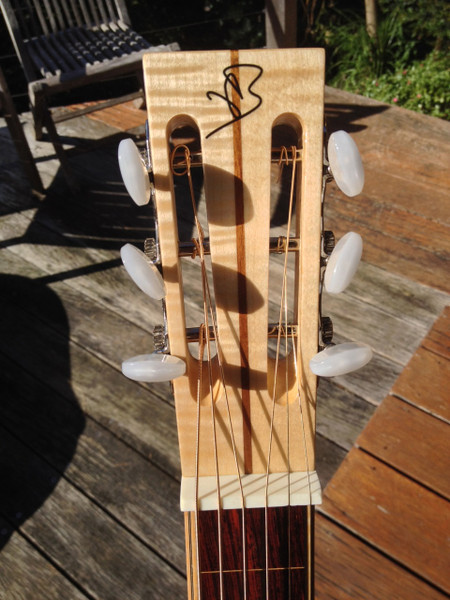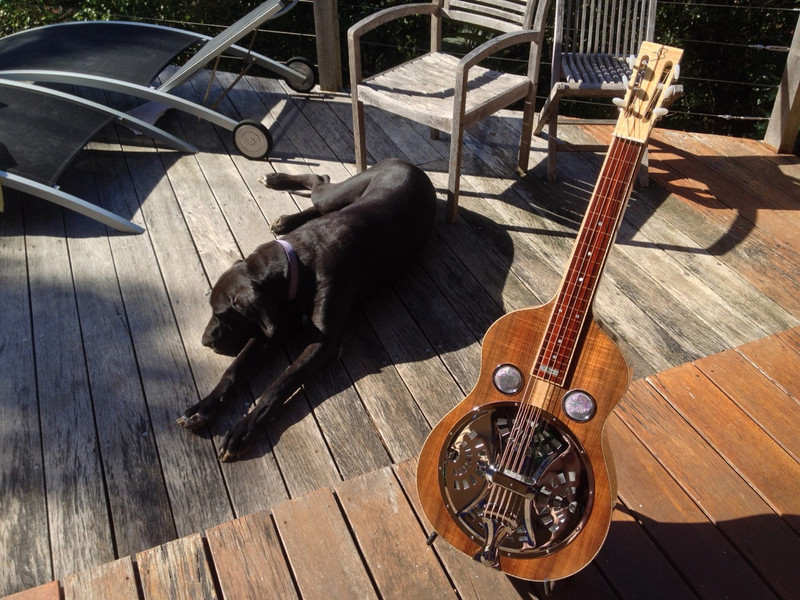Page 1 of 2
Spider reso weissenborn
Posted: 11 May 2014 4:38 pm
by Xavier Baron
Hi everybody
Just wanted to show some pictures of my actual build, a wood spider reso weissenborn.
It should look almost like the old national brass tricones but with a dobro gear
The trickest thing was to bend the back !



[/URL]

[/URL]
I finally got it



The wood is high grade black acacia and the fingerboard is cocobolo with maple frets, the fingerboard finish is CA glue:


More to come soon
Cheers,
Xavier
Posted: 11 May 2014 4:40 pm
by Rick Barnhart
Very very nice work,, Xavier

Posted: 11 May 2014 9:38 pm
by Xavier Baron
Thanks Rick

As I said the tricky thing was to bend the back to shape.
My first mistake was to tey to bend it with the back jointed. Notice that I used Titebond III and it did the job even under the steam iron

I thinned the back to 2 mm and thinned the back reinforcement strip down to 1.2 mm. Tried to bend it in shape over the sides, and had poor results.Tried to kerf the reinforcement strip, heat, clamps...

Finally I added more braces in the bended part (2 glued on the sides and two directly on the back (Now I know that two is not enough, next time I'll glue one on the sides every cm), and could soften the wood with... household denatured alcohol, and it worked



next difficulty will be to bend the curly maple back bindings... as they'll have to be bended followind the back

In two or threee monthes she should sing

Hope the alcohol trick can help
Next time: bend the 2 parts of the back over a mold then glue the joint!!!
Xavier
Posted: 12 May 2014 11:03 am
by Paddy Burgin
Beautiful work.
Paddy Burgin
www.burginguitars.co.nz
Posted: 12 May 2014 1:43 pm
by Michael Kienhofer
Great Work!!
Just love the color of that fretboard!!
Posted: 25 May 2014 7:14 pm
by Xavier Baron
Hi guys,
The alcohol tip works grat for maple bindings, too
These ones were soaked for some hours in household alcohol, ant cold bent directly on the body in a minute:

Notice that the bend is in the three axes
Xavier
Posted: 26 May 2014 3:54 am
by Michael Kienhofer
Thanks great tip !
Will try this trick in the future
Posted: 28 Jun 2014 7:48 pm
by Xavier Baron
Posted: 29 Jun 2014 6:30 am
by Dave Broyles
That's cool! How does it sound?
Posted: 29 Jun 2014 7:04 am
by Michael Kienhofer

Your work never fails to impress!
Posted: 29 Jun 2014 11:21 am
by Alan Brookes
Very impressive workmanship. Have you considered building a 7 or 8 string instrument, which would work better for C6 tuning?
Posted: 29 Jun 2014 1:12 pm
by Xavier Baron
Thanks

Ill try to post some sample sounds later
Well it sounds... great to me, I like it, different but as good as my 2001 F60 Dobro, even with a brand new cone
And it doesnt buzz

Alan, maybe later for the 7 or 8 strings... Now I'm happy not to have to work on it anymore, now it's time to rest and play

I suppose I could keep the same mold and just to enlarge it a little on the head to enlarge the fingerboard.
For a 7 strings C6 vs a 6 strings, the 7th string would be a bass or a trebble one ?
Can a 7 strings spider saddle be easily notched? the middle string may be just in the middle of the saddle, wher there is the tension screw?
Posted: 29 Jun 2014 3:09 pm
by Alan Brookes
Xavier Baron wrote:...For a 7 strings C6 vs a 6 strings, the 7th string would be a bass or a treble one ?
Can a 7 strings spider saddle be easily notched? the middle string may be just in the middle of the saddle, where there is the tension screw?
With the C6 tuning the extra string would be between the 3rd and 4th string. You would build a new bridge and notch it. If you wanted the screw to be in the middle then an 8-string would be better than a 7-string, but it doesn't need to be exactly in the middle. The way I look at it, anything you can play on a 7-string you can play on an 8-string, but not vice-versa, so if you're going to build from scratch you might as well go for eight strings.
For the usual Dobro Open G tuning, preferred by most bluegrass and country players, the extra strings wouldn't be of much use. It would be difficult to tune a string too far above the 1st (D) string without string breakage, but an extra string on the bass side tuned down to D would be useful.
Posted: 29 Jun 2014 7:51 pm
by Xavier Baron
Posted: 4 Jul 2014 9:30 am
by Mike D
Sounds nice and great playing.
Posted: 4 Jul 2014 9:50 am
by Peter den Hartogh
Are the tuners installed the right way?
Posted: 4 Jul 2014 12:24 pm
by Xavier Baron
Peter den Hartogh wrote:Are the tuners installed the right way?
What do you mean, Peter?
Posted: 4 Jul 2014 1:22 pm
by Alan Brookes
Peter den Hartogh wrote:Are the tuners installed the right way?
Gears above the worms is the way most string instrument tuners are installed, and that's the way Xavier has done it. But they work the other round way, too. It's all a matter of what angle you want the strings to be at the bridge. Also most people wind the strings over the rollers, as Xavier has done.
Tuner knobs above the peghead is normal for square-necked instruments, as Xavier has done.
In what other way would you recommend that Xavier install the tuners?

Posted: 4 Jul 2014 2:13 pm
by Peter den Hartogh
When you install the tuners with the gears below the worms, the string tension will pull the gears towards the worms, making a better connection.
Posted: 4 Jul 2014 7:03 pm
by Michael Maddex
Alan Brookes wrote:... Gears above the worms is the way most string instrument tuners are installed, ...
Sorry, Alan, I know that you are an experienced luthier, but that is flat backwards wrong! Think about what Peter wrote above.
That is the way string instrument tuners are properly installed.

Posted: 4 Jul 2014 8:44 pm
by Xavier Baron
Peter,
What you say have sense for standard peg heads, but I don't think that it is really important for slotted ones…? The way I placed them, the strings tension makes a tight contact with the gears.
Posted: 5 Jul 2014 3:38 am
by Peter den Hartogh
Yes, I think you are right about the slotted pegheads as opposed to the standard pegheads. There will be a difference because the pivot point is in a different position.
I admire your project, it looks stunning

well done!
Posted: 5 Jul 2014 9:31 am
by Alan Brookes
Peter den Hartogh wrote:When you install the tuners with the gears below the worms, the string tension will pull the gears towards the worms, making a better connection.
I see your point, and I've installed tuners both ways over the years. My choice usually has more to do with the distance available between the rollers and the nut, which alters the angle at the nut, and, hence, the pressure on the nut. Lightly-tuned instruments need a more severe angle to avoid rattling. That's why lutes have such a downward-facing peghead. Of course, lutes traditionally have friction pegs, which can be strung to turn in either direction.
Posted: 6 Jul 2014 10:13 pm
by Ferdinand van den Berg
Hi Xavier,
Great work! And thanks to share the alcohol trickwith us, I wil try it out.
One thing I still don't get is your problems with bending the back. Was it difficult for this Weissenborn because of the resonator construction? With a normal Weissenborn I have never much problems with bending, I just glue !a arched sanding block, but that's it. I am curious about how you did it.
Thanks!
Posted: 6 Jul 2014 10:22 pm
by Xavier Baron
Hi Ferdinand,
Thanks for the kind words!
The reso construction was not the problem, but the shape of the profile:

There was a "S" bending to shape it…
The alcohol tip works really nicely with maple, but not so much with ebony and rosewood

Xavier


 [/URL]
[/URL] [/URL]
[/URL]






 [/URL]
[/URL] [/URL]
[/URL]












